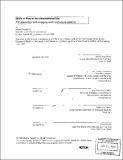Work 'n' play in the informational city : F2F interaction and emerging work and leisure patterns
Author(s)
Palasthira, Malina, 1971-
DownloadFull printable version (11.56Mb)
Alternative title
Work and play in the informational city
F2F interaction and emerging work and leisure patterns
Other Contributors
Massachusetts Institute of Technology. Dept. of Urban Studies and Planning.
Advisor
Eran Ben-Joseph and Ann Pendleton-Jullian.is chosen as the testing ground for mixing work and play. An office-hoteling tower is proposed atop the terminal, occupying its valuable air rights while drawing some of the public flow of people through a vertical series of public places. Keeping with the true spirit of the digital age, where fine-grain mixing and strange hybrids are the norm, the project attempts to redefine the relationship between work and play, public and private, natural and artificial, real and virtual, as well as mind and body.
Terms of use
Metadata
Show full item recordAbstract
The death of distance does not equal the death of cities and of urban life. Cities are transforming their roles and functions in reaction to a major technological shift --from post-industrial to informational. And contrary to popular belief, new telecommunications infrastructure will increase the significance of some cities as important physical meeting places. A host of new network cities have emerged from this new global infrastructure which supports the rapidly growing world of information technology. These cities, once the centers of manufacturing, are now the centers for the production of information that is distributed electronically around the globe. Contemporary cities are not just dense physical agglomerations of buildings, the crossroads of transportation networks, or the main center of economic, social and cultural life, but also the electronic hubs for telecommunication networks. Techno logy has extended the geographic reach of these cities to enable their denizens to interact more, both electronically and face-to-face. And as the material and intellectual basis of our society change due to the new digital revolution, widely accepted dichotomies --in particular, real/virtual, mind/body, local/global and natural/artificial-- are blurred and call for re-redefinition. New patterns of living and working are also emerging from these changes. By far, the largest impact of this electronic communication network is on the workplace, particularly in the growing area of information work. The workplace is today much more flexible both in terms of time and place. I believe that the office, now only one of many workplaces, will be used especially for intense face-to-face and collaborative work. Th is flexible and more sociable aspect of work and the ubiquitous and fine-grained nature of digital flow is blurring the, once, clear boundary between work and leisure. The thesis proposes an alternative design strategy, one centered around the aspect of work which is highly sociable. The Port Authority Bus Terminal in Manhattan --a defunct but extremely busy hub--
Description
Thesis (S.M.)--Massachusetts Institute of Technology, Dept. of Architecture; and, (M.C.P.)--Massachusetts Institute of Technology, Dept. of Urban Studies and Planning, 1999. Includes bibliographical references (p. [116]-[117]).
Date issued
1999Department
Massachusetts Institute of Technology. Department of Architecture; Massachusetts Institute of Technology. Department of Urban Studies and PlanningPublisher
Massachusetts Institute of Technology
Keywords
Architecture., Urban Studies and Planning.